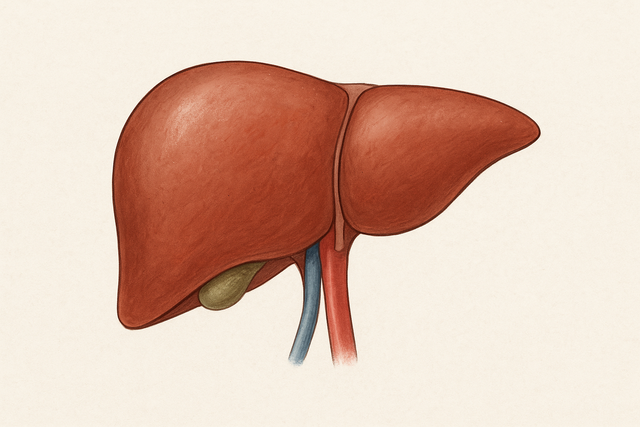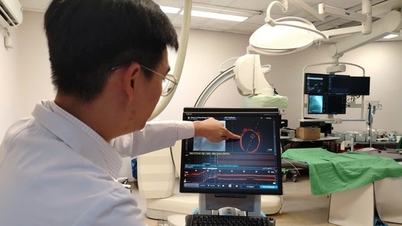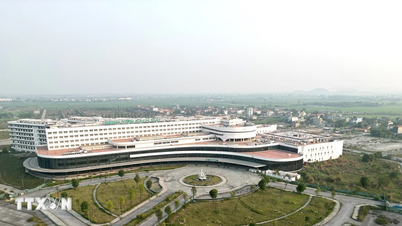If detected early, people with liver disease have a higher chance of survival. However, this type of disease often has no obvious symptoms in the early stages.
Predicting the risk of liver disease 10 years in advance
Swedish researchers have developed a test that can predict the risk of serious liver disease 10 years in advance, allowing early intervention and treatment to prolong life, according to the Daily Mail (UK).
This testing method is called CORE, based on 5 factors: age, gender and 3 common liver enzymes in blood tests (AST, ALT, GGT) - indicators often checked in periodic health check-ups.

CORE test model has the ability to predict the risk of liver disease 10 years in advance
ILLUSTRATION: AI
The team analyzed data from more than 480,000 people in Stockholm, who all underwent health checks between 1985 and 1996. After 30 years of follow-up, the team found that 1.5% of them developed serious liver disease such as cirrhosis, liver cancer or needed a liver transplant.
The CORE model produced clear results, able to distinguish between those who would develop the disease and those who would not with up to 88% accuracy, better than the currently recommended FIB-4 method - which is used to assess the risk of liver disease, especially in people with fatty liver.
“Basic medicine currently does not have a sufficiently effective tool for early detection of serious liver disease,” said Professor Hannes Hagström, head of the research team at the Karolinska Institutet Medical School in Sweden. “FIB-4 is not suitable for the general population and is less effective in predicting future liver disease risk.”
Notably, the CORE model has also been tested on two other population groups in Finland and the UK, showing the ability to detect liver disease with high accuracy.
However, scientists stress that more research is needed to assess the effectiveness of this type of test, especially in high-risk groups such as people with type 2 diabetes or obesity.

Liver disease rates are rising rapidly among young people, partly due to lack of exercise and poor nutrition.
PHOTO: AI
Liver disease rates are rising in young people
If in the past liver disease was mainly found in the elderly and people who drank a lot of alcohol, now according to experts, the incidence is increasing rapidly in young people, partly due to a sedentary lifestyle and ultra-processed foods containing a lot of salt, fat and sugar.
Types of liver disease include:
- Alcoholic liver disease.
- Non-alcoholic fatty liver disease.
- Hepatitis.
- Heemochromatosis.
- Primary biliary cholangitis.
People with alcoholic liver disease may experience symptoms such as nausea, weight loss, loss of appetite, and jaundice or yellowing of the skin or eyes. Meanwhile, people with non-alcoholic fatty liver disease often experience fatigue, discomfort, or pain in the liver area, which is on the right side of the abdomen below the ribs.
Source: https://thanhnien.vn/xet-nghiem-moi-giup-du-doan-nguy-co-ton-thuong-gan-truoc-nhieu-nam-185251016234208735.htm




![[Photo] The captivating scenery of the fragrant maple forest in Quang Tri](/_next/image?url=https%3A%2F%2Fvphoto.vietnam.vn%2Fthumb%2F1200x675%2Fvietnam%2Fresource%2FIMAGE%2F2025%2F12%2F10%2F1765353233198_lan09046-jpg.webp&w=3840&q=75)

![[Photo] Explore the US Navy's USS Robert Smalls warship](/_next/image?url=https%3A%2F%2Fvphoto.vietnam.vn%2Fthumb%2F1200x675%2Fvietnam%2Fresource%2FIMAGE%2F2025%2F12%2F10%2F1765341533272_11212121-8303-jpg.webp&w=3840&q=75)
































![[Video] The craft of making Dong Ho folk paintings has been inscribed by UNESCO on the List of Crafts in Need of Urgent Safeguarding.](https://vphoto.vietnam.vn/thumb/402x226/vietnam/resource/IMAGE/2025/12/10/1765350246533_tranh-dong-ho-734-jpg.webp)










































































Comment (0)